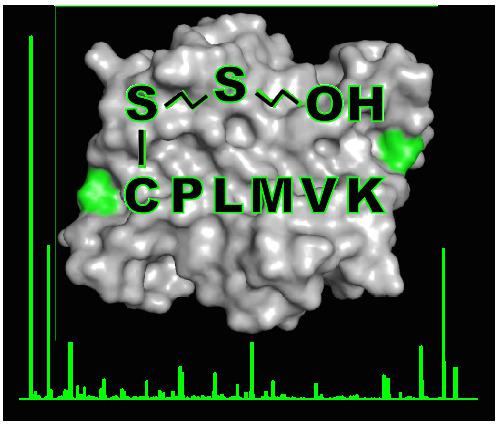当前位置:
X-MOL 学术
›
Drug Test. Anal.
›
论文详情
Our official English website, www.x-mol.net, welcomes your
feedback! (Note: you will need to create a separate account there.)
Transthyretin as a target of alkylation and a potential biomarker for sulfur mustard poisoning: Electrophoretic and mass spectrometric identification and characterization
Drug Testing and Analysis ( IF 2.6 ) Pub Date : 2021-08-16 , DOI: 10.1002/dta.3146 Wolfgang Schmeißer 1 , Robin Lüling 1, 2 , Dirk Steinritz 1, 2, 3 , Horst Thiermann 1 , Theo Rein 4 , Harald John 1
Drug Testing and Analysis ( IF 2.6 ) Pub Date : 2021-08-16 , DOI: 10.1002/dta.3146 Wolfgang Schmeißer 1 , Robin Lüling 1, 2 , Dirk Steinritz 1, 2, 3 , Horst Thiermann 1 , Theo Rein 4 , Harald John 1
Affiliation

|
For the verification of exposure to the banned blister agent sulfur mustard (SM) and the better understanding of its pathophysiology, protein adducts formed with endogenous proteins represent an important field of toxicological research. SM and its analogue 2-chloroethyl ethyl sulfide (CEES) are well known to alkylate nucleophilic amino acid side chains, for example, free-thiol groups of cysteine residues. The specific two-dimensional thiol difference gel electrophoresis (2D-thiol-DIGE) technique making use of maleimide dyes allows the staining of free cysteine residues in proteins. As a consequence of alkylation by, for example, SM or CEES, this staining intensity is reduced. 2D-thiol-DIGE analysis of human plasma incubated with CEES and subsequent matrix-assisted laser desorption/ionization time-of-flight (tandem) mass-spectrometry, MALDI-TOF MS(/MS), revealed transthyretin (TTR) as a target of alkylating agents. TTR was extracted from SM-treated plasma by immunomagnetic separation (IMS) and analyzed after tryptic cleavage by microbore liquid chromatography-electrospray ionization high-resolution tandem-mass spectrometry (μLC-ESI MS/HR MS). It was found that the Cys10-residue of TTR present in the hexapeptide C(-HETE)PLMVK was alkylated by the hydroxyethylthioethyl (HETE)-moiety, which is characteristic for SM exposure. It was shown that alkylated TTR is stable in plasma in vitro at 37°C for at least 14 days. In addition, C(-HETE)PLMVK can be selectively detected, is stable in the autosampler over 24 h, and shows linearity in a broad concentration range from 15.63 μM to 2 mM SM in plasma in vitro. Accordingly, TTR might represent a complementary protein marker molecule for the verification of SM exposure.
中文翻译:

转甲状腺素蛋白作为烷基化的靶标和硫芥中毒的潜在生物标志物:电泳和质谱鉴定和表征
为了验证与禁用的起泡剂硫芥 (SM) 的接触情况并更好地了解其病理生理学,与内源性蛋白质形成的蛋白质加合物代表了毒理学研究的一个重要领域。众所周知,SM 及其类似物 2-氯乙基乙基硫醚 (CEES) 可以烷基化亲核氨基酸侧链,例如半胱氨酸残基的游离硫醇基团。使用马来酰亚胺染料的特定二维硫醇差异凝胶电泳 (2D-硫醇-DIGE) 技术允许对蛋白质中的游离半胱氨酸残基进行染色。作为通过例如 SM 或 CEES 进行烷基化的结果,这种染色强度会降低。用 CEES 和随后的基质辅助激光解吸/电离飞行时间(串联)质谱法对人血浆进行 2D-硫醇-DIGE 分析,MALDI-TOF MS(/MS) 揭示转甲状腺素蛋白 (TTR) 作为烷化剂的目标。通过免疫磁分离 (IMS) 从 SM 处理的血浆中提取 TTR,并在胰蛋白酶裂解后通过微孔液相色谱-电喷雾电离高分辨率串联质谱 (μLC-ESI MS/HR MS) 进行分析。发现Cys存在于六肽 C(-HETE)PLMVK 中的 TTR 的10残基被羟乙基硫乙基 (HETE)-部分烷基化,这是 SM 暴露的特征。显示烷基化 TTR 在体外血浆中在 37°C 下稳定至少 14 天。此外,C(-HETE)PLMVK 可以被选择性检测,在自动进样器中稳定超过 24 小时,并且在体外血浆中从 15.63 μM 到 2 mM SM 的宽浓度范围内显示出线性。因此,TTR 可能代表用于验证 SM 暴露的互补蛋白质标记分子。
更新日期:2021-08-16
中文翻译:

转甲状腺素蛋白作为烷基化的靶标和硫芥中毒的潜在生物标志物:电泳和质谱鉴定和表征
为了验证与禁用的起泡剂硫芥 (SM) 的接触情况并更好地了解其病理生理学,与内源性蛋白质形成的蛋白质加合物代表了毒理学研究的一个重要领域。众所周知,SM 及其类似物 2-氯乙基乙基硫醚 (CEES) 可以烷基化亲核氨基酸侧链,例如半胱氨酸残基的游离硫醇基团。使用马来酰亚胺染料的特定二维硫醇差异凝胶电泳 (2D-硫醇-DIGE) 技术允许对蛋白质中的游离半胱氨酸残基进行染色。作为通过例如 SM 或 CEES 进行烷基化的结果,这种染色强度会降低。用 CEES 和随后的基质辅助激光解吸/电离飞行时间(串联)质谱法对人血浆进行 2D-硫醇-DIGE 分析,MALDI-TOF MS(/MS) 揭示转甲状腺素蛋白 (TTR) 作为烷化剂的目标。通过免疫磁分离 (IMS) 从 SM 处理的血浆中提取 TTR,并在胰蛋白酶裂解后通过微孔液相色谱-电喷雾电离高分辨率串联质谱 (μLC-ESI MS/HR MS) 进行分析。发现Cys存在于六肽 C(-HETE)PLMVK 中的 TTR 的10残基被羟乙基硫乙基 (HETE)-部分烷基化,这是 SM 暴露的特征。显示烷基化 TTR 在体外血浆中在 37°C 下稳定至少 14 天。此外,C(-HETE)PLMVK 可以被选择性检测,在自动进样器中稳定超过 24 小时,并且在体外血浆中从 15.63 μM 到 2 mM SM 的宽浓度范围内显示出线性。因此,TTR 可能代表用于验证 SM 暴露的互补蛋白质标记分子。











































 京公网安备 11010802027423号
京公网安备 11010802027423号